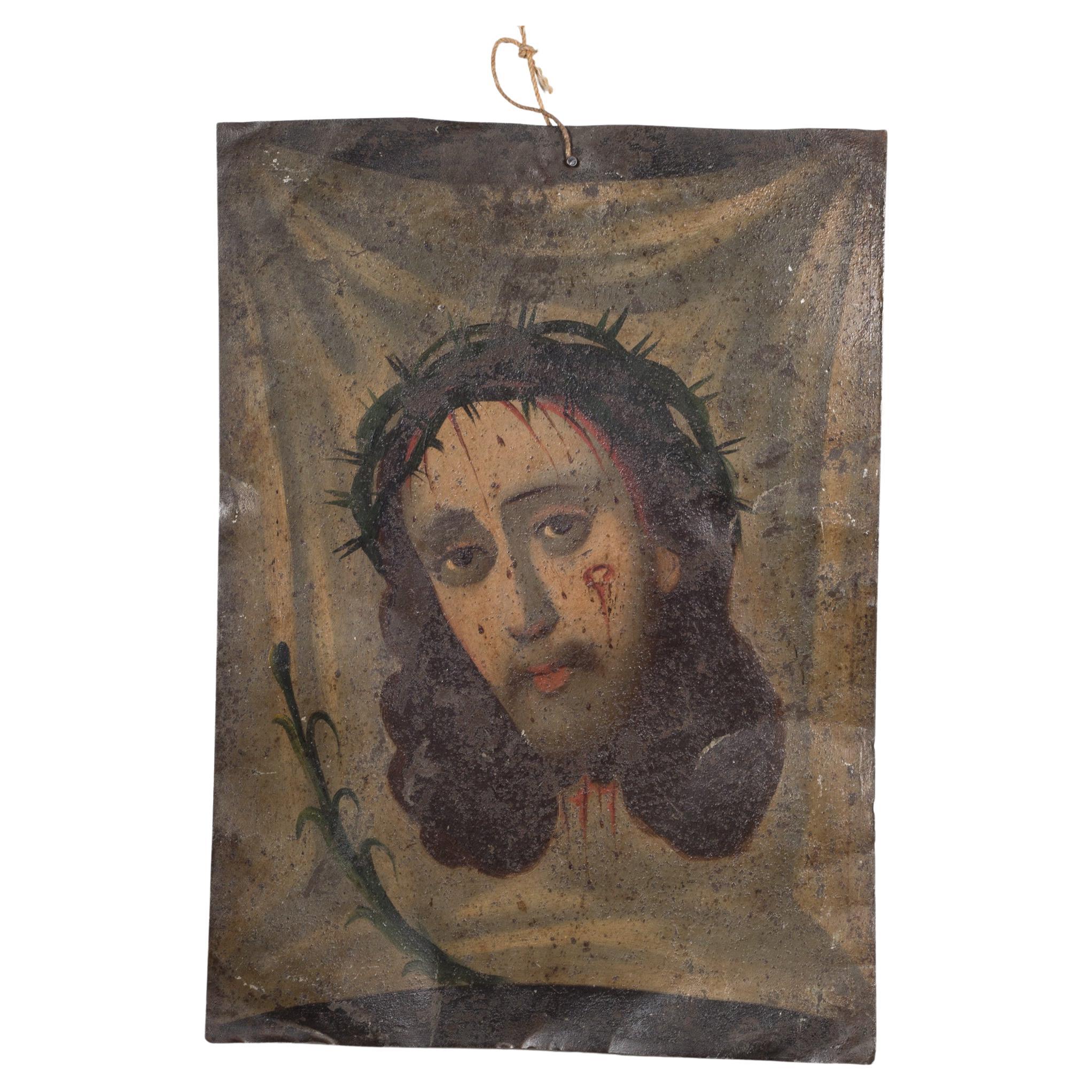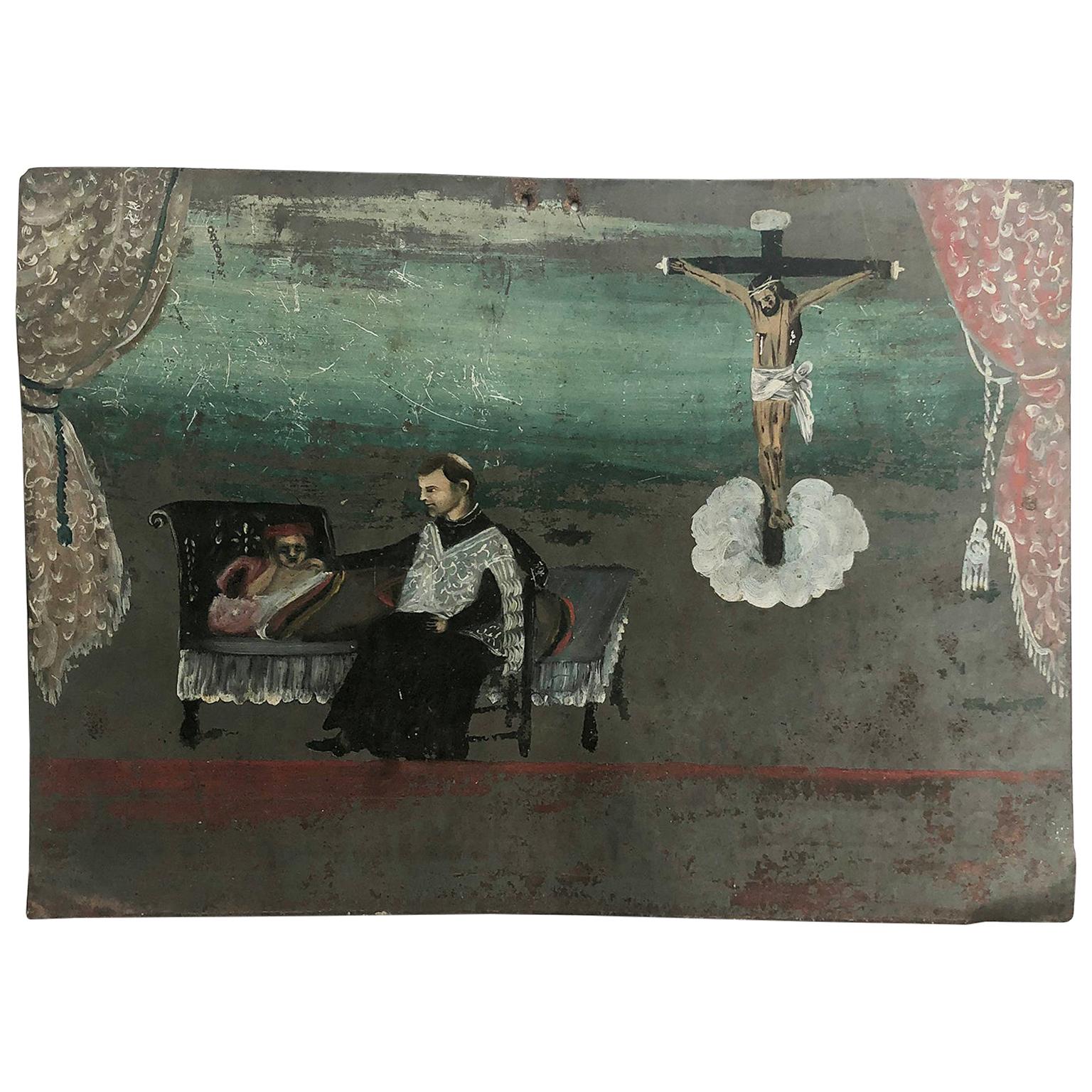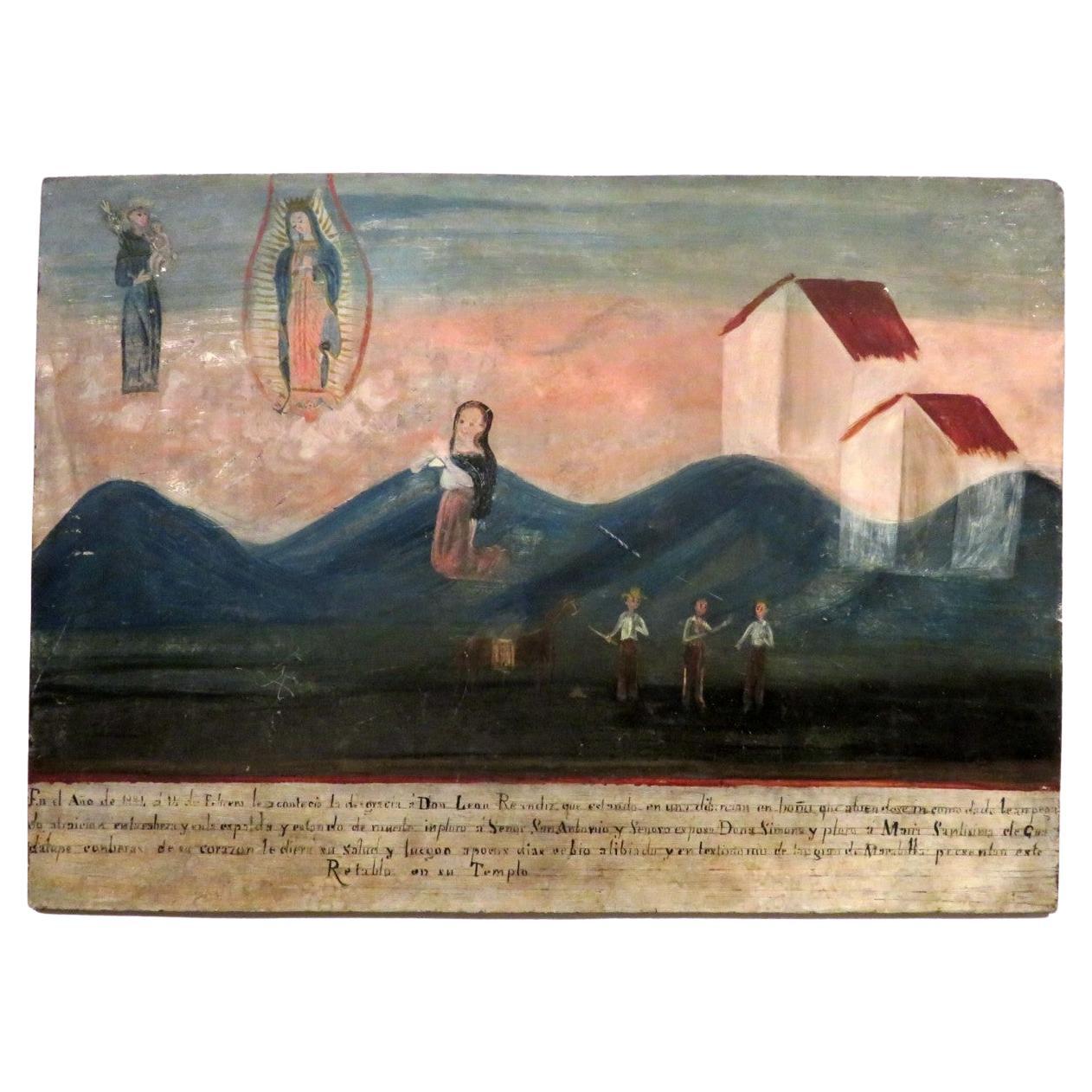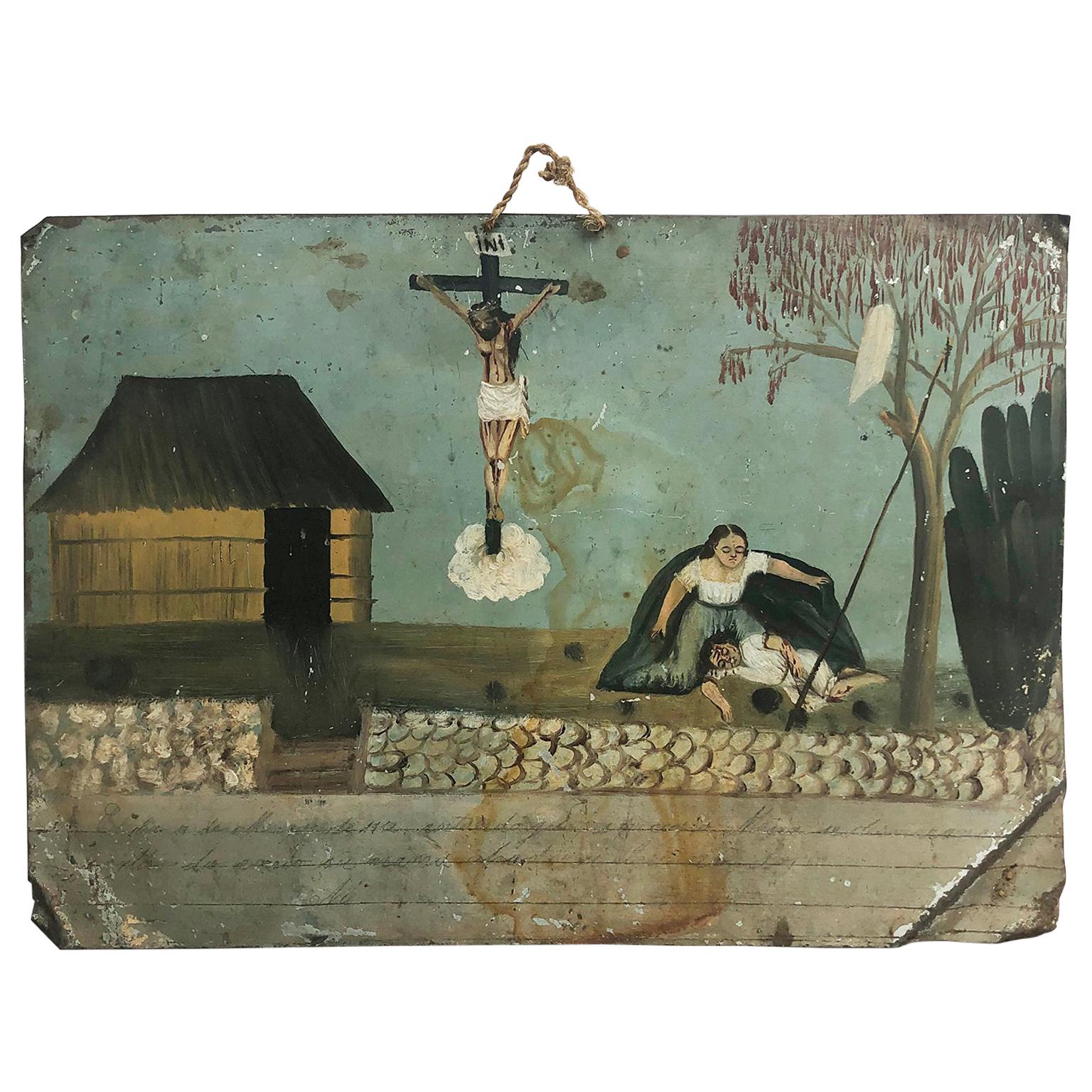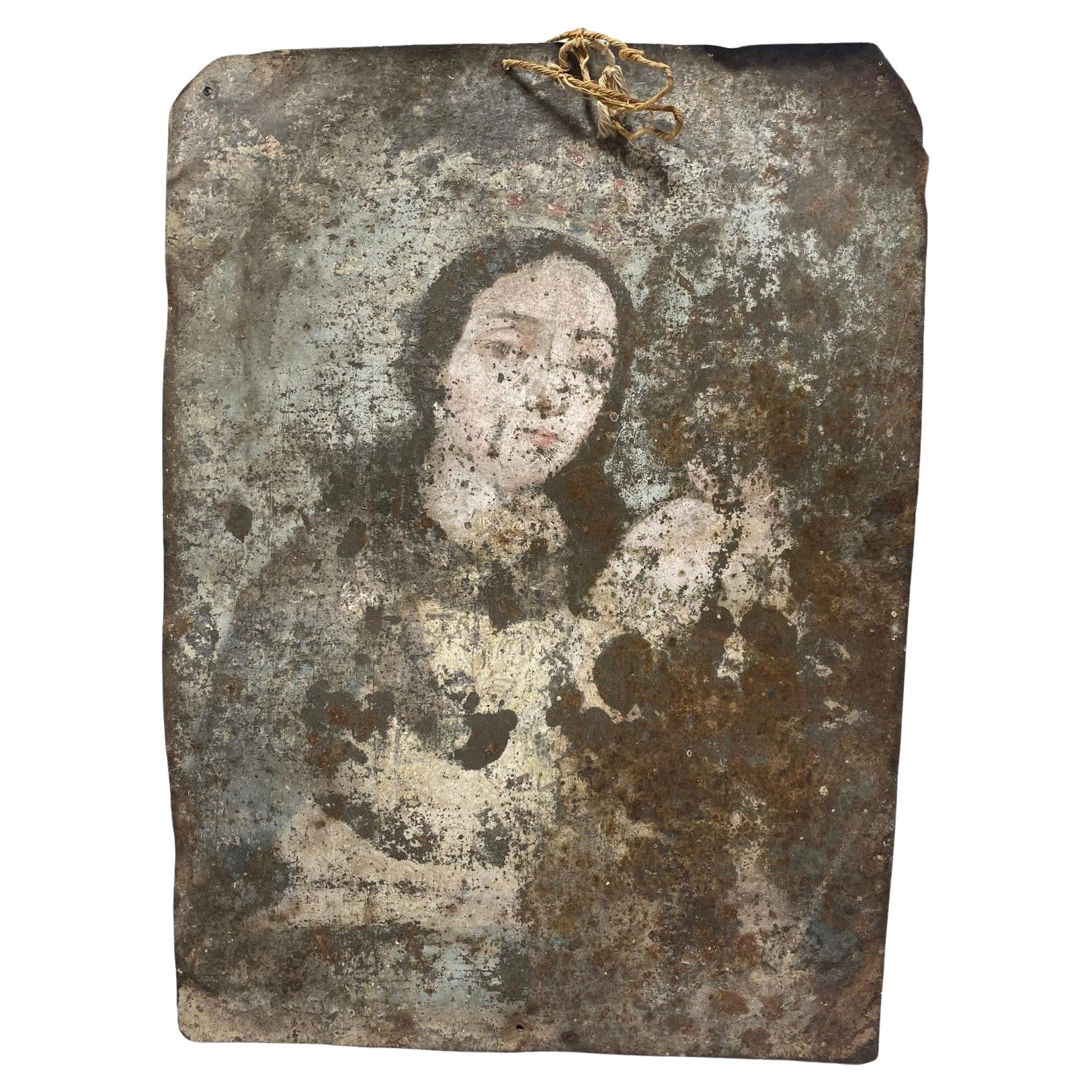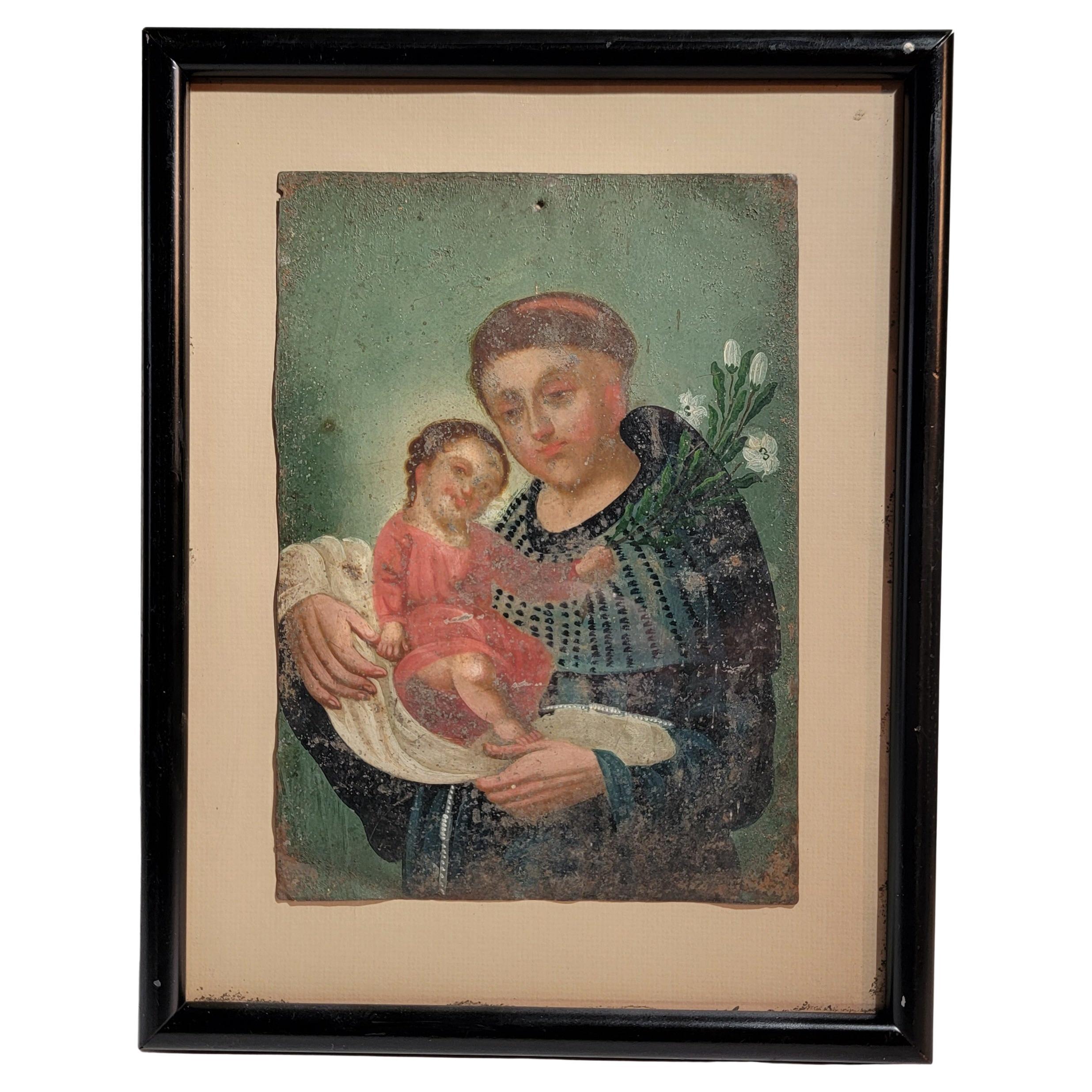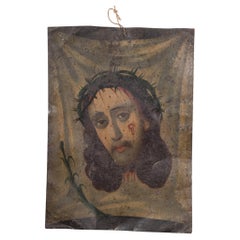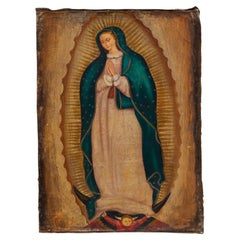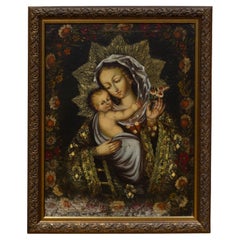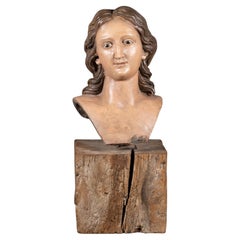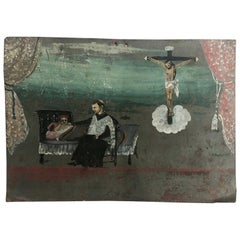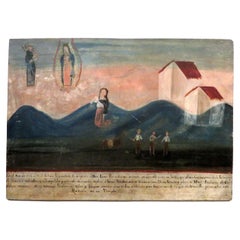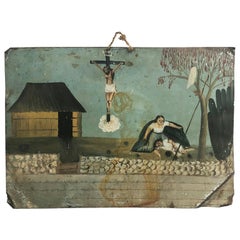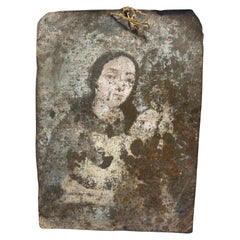Items Similar to 19th C. Mexican Retablo "Veronica's Veil", c.1880
Want more images or videos?
Request additional images or videos from the seller
1 of 5
19th C. Mexican Retablo "Veronica's Veil", c.1880
$1,155
£881.68
€1,013.55
CA$1,625.29
A$1,807.39
CHF 949.28
MX$22,097.18
NOK 11,828.95
SEK 11,151.51
DKK 7,564.37
About the Item
About
An original 19th century Mexican folk retablo "Veronica's Veil" or "El Divono Rostro" in Spain . Oil paint on tin.
The Veil of Veronica, known in Italian as the Volto Santo or Holy Face, is a Roman Catholic Relic which, according to legend, bears the likeness of the Face of Jesus that was imprinted on it prior to Jesus' crucifixion. According to Roman Catholicism, Saint Veronica encountered Jesus in Jeruselum on the way to Calvary. When she paused to wipe the sweat (Latin, suda) off his face with her veil, his image was left on the veil.
In the small village of Osa de la Vega in Spain, there lived a couple who led a very pious life. They were Gregorio de la Torre and Isabel Corral. From their father, Juan Montilla, they inherited a picture of the Face of Jesus or the Divino Rostro. A story that is told one day, to the amazement of many who confirmed its veracity, the picture began to perspire with living blood. News of this extraordinary event spread swiftly and widely throughout the land.
CREATOR Unknown.
DATE OF MANUFACTURE c.1880.
MATERIALS AND TECHNIQUES Oil Paint on Tin.
CONDITION Good. Wear consistent with age and use.
DIMENSIONS H 14 in. W 10 in.
HISTORY
Retablos, better known as 'laminas' in Mexico, are small oil paintings on tin, wood and sometimes copper which were used in home altars to venerate the almost infinite number of Catholic saints. The literal translation for 'retablo' is 'behind the altar.' This unique genre of art, deeply rooted in European history, was brought to Mexico with the arrival of the Spanish and then ultimately adopted by New World mestizo natives to become what is known today as the Mexican folk retablo.
The retablo was an art form that flourished in post conquest Mexico and then ultimately, with the introduction of inexpensive mediums such as tin, reached its pinnacle of popularity in the last quarter of the 19th century. With some exceptions, mostly untrained artists from the provinces worked to produce and reproduce these sacred images; some subjects painted more prolifically than others. A typical "retablero" may have reproduced the same image hundreds, if not thousands of times in his or her career.
These oil paintings were sold to devout believers who displayed them in home altars to honor their patron saints. There are virtually hundreds of saints, each invoked to remedy a different situation. "San Ysidro Labrador," the patron saint of farmers, is venerated for good weather, agricultural issues and prosperous crop. He is often called upon before picnics or just before harvest. Having spent four years in the forest as a hermit, San Jeronimo, the patron saint of scholars and philosophers, is invoked for protection against temptations and want.
Bearing some semblance to retablos, 'ex-votos' are devotional paintings on canvas or tin which offer thanks to a particular saint in the form of a short narrative. In many events, a small child becomes ill, a soldier returns safely from war, or a favorite animal is reunited with its owner. The petitioner, grateful for this miracle, dedicated a small painting (with a short testimonial) to the respective patron Saint.
These unique art forms are a hybrid of centuries old Catholic iconography and indigenous artistry; reflecting the historical, cultural and religious links between "old" and "new" worlds.
- Dimensions:Height: 14 in (35.56 cm)Width: 10 in (25.4 cm)Depth: 0.2 in (5.08 mm)
- Style:Folk Art (Of the Period)
- Materials and Techniques:
- Place of Origin:
- Period:
- Date of Manufacture:1880
- Condition:Wear consistent with age and use.
- Seller Location:San Francisco, CA
- Reference Number:1stDibs: LU1280227920942
About the Seller
5.0
Vetted Professional Seller
Every seller passes strict standards for authenticity and reliability
Established in 2014
1stDibs seller since 2015
1,330 sales on 1stDibs
Typical response time: 1 hour
- ShippingRetrieving quote...Shipping from: San Francisco, CA
- Return Policy
Authenticity Guarantee
In the unlikely event there’s an issue with an item’s authenticity, contact us within 1 year for a full refund. DetailsMoney-Back Guarantee
If your item is not as described, is damaged in transit, or does not arrive, contact us within 7 days for a full refund. Details24-Hour Cancellation
You have a 24-hour grace period in which to reconsider your purchase, with no questions asked.Vetted Professional Sellers
Our world-class sellers must adhere to strict standards for service and quality, maintaining the integrity of our listings.Price-Match Guarantee
If you find that a seller listed the same item for a lower price elsewhere, we’ll match it.Trusted Global Delivery
Our best-in-class carrier network provides specialized shipping options worldwide, including custom delivery.More From This Seller
View All19th c. Mexican Retablo "Veronica's Veil" c.1880
Located in San Francisco, CA
ABOUT
An original 19th century Mexican folk retablo "Veronica's Veil" or "El Divono Rostro" in Spain . Oil paint on tin.
The Veil of Veronica, known in Italian as the Volto Santo or Holy Face, is a Roman Catholic Relic which, according to legend, bears the likeness of the Face of Jesus that was imprinted on it prior to Jesus' crucifixion. According to Roman Catholicism, Saint Veronica encountered Jesus in Jeruselum on the way to Calvary. When she paused to wipe the sweat (Latin, suda) off his face with her veil, his image was left on the veil.
In the small village of Osa de la Vega in Spain, there lived a couple who led a very pious life. They were Gregorio de la Torre and Isabel Corral. From their father, Juan Montilla, they inherited a picture of the Face of Jesus or the Divino Rostro. A story that is told one day, to the amazement of many who confirmed its veracity, the picture began to perspire with living blood. News of this extraordinary event spread swiftly and widely throughout the land.
CREATOR Unknown.
DATE OF MANUFACTURE c.1880.
MATERIALS AND TECHNIQUES Oil Paint on Tin.
CONDITION Good. Wear consistent with age and use.
DIMENSIONS H 14 in. W 10 in.
HISTORY
Retablos, better known as 'laminas' in Mexico, are small oil paintings on tin, wood and sometimes copper which were used in home altars to venerate the almost infinite number of Catholic saints. The literal translation for 'retablo' is 'behind the altar.' This unique genre of art, deeply rooted in European history, was brought to Mexico with the arrival of the Spanish and then ultimately adopted by New World mestizo natives to become what is known today as the Mexican folk retablo.
The retablo was an art form that flourished in post conquest Mexico and then ultimately, with the introduction of inexpensive mediums such as tin, reached its pinnacle of popularity in the last quarter of the 19th century. With some exceptions, mostly untrained artists from the provinces worked to produce and reproduce these sacred images; some subjects painted more prolifically than others. A typical "retablero" may have reproduced the same image hundreds, if not thousands of times in his or her career.
These oil paintings were sold to devout believers who displayed them in home altars to honor their patron saints. There are virtually hundreds of saints, each invoked to remedy a different situation. "San Ysidro Labrador," the patron saint of farmers, is venerated for good weather...
Category
Antique 19th Century Mexican Folk Art Paintings
Materials
Tin
Early 20th c. Virgin of Guadalupe, Bolivia, Oil on Canvas Painting
Located in San Francisco, CA
ABOUT
Virgin of Guadalupe, unsigned, oil on canvas, unframed.
CREATOR Unsigned.
DATE OF MANUFACTURE c.1910-1940.
MATERIALS AND TECHNIQUES Oil on Canvas.
CONDITION...
Category
Early 20th Century Bolivian Spanish Colonial Paintings
Materials
Paint
Madonna & Child, Peru, Oil on Canvas Painting, pre 1970
Located in San Francisco, CA
ABOUT
Peruvian Cuzco School, Madonna & Child, Untitled. Oil on canvas, pre 1970.
CREATOR Unsigned.
DATE OF MANUFACTURE c. pre 1970.
MATERIALS AND TECHNIQUES Oil on Canv...
Category
Mid-20th Century Peruvian Paintings
Materials
Wood, Paint
$1,800 Sale Price
30% Off
Early 19th Century Terracotta Bust with Glass Eyes, Circa1800-1840
Located in San Francisco, CA
About
An early 19th century painted terracotta bust with glass eyes on wooden base.
Creato Unknown.
Date of manufacture circa1...
Category
Antique Early 19th Century American Victorian Figurative Sculptures
Materials
Wood, Paint
$1,165 Sale Price
22% Off
Mid-20th Century Carved Wooden Santo, circa 1950-1960
Located in San Francisco, CA
About
A hand painted carved wooden Mexican or Central American Santo (saint) with articulating arms.
Creator unknown.
Date of manufacture circa 1...
Category
Antique 19th Century Mexican Industrial Figurative Sculptures
Materials
Wood, Paint
$175 Sale Price
32% Off
Late 17th/Early 18th C. Carved Wood Hunting Panel C.1680-1750
Located in San Francisco, CA
A late 17th/early 18th century Flemish or Dutch
carved wood panel, possibly from a wall paneling, or a component of a
large cabinet, likely from a hunting lodge.
Category
Antique Late 17th Century Rustic Sculptures and Carvings
Materials
Wood
$950 Sale Price
49% Off
You May Also Like
Original Mexican Retablo "Exvotos" Oil on Tin
Located in Mexico City, CDMX
We offer this original Mexican ex voto, due to the effects of time, the writing has been erased.
Category
Vintage 1930s Mexican Folk Art Religious Items
Materials
Metal
$1,050 Sale Price
30% Off
A Very Good 19th Century Hand Painted Mexican Retablo Dated 1884
Located in Ottawa, Ontario
The naïve, hand painted vignette depicts a woman praying to the images of Saint Anthony holding The Christ Child, together with The Holy Mother, all shown hovering above a group of t...
Category
Antique Late 19th Century Mexican Folk Art Religious Items
Materials
Tin
Original Mexican Retablo "Exvotos" Oil on Tin
Located in Mexico City, CDMX
We offer this original Mexican Retablo "Exvotos" oil on tin, circa 1920.
Category
Vintage 1920s Mexican Folk Art Antiquities
Materials
Metal
$1,400 Sale Price
30% Off
Colonial Mexican Folk Art Ex-Voto Retablo Painting of Mother Mary & Jesus, 1800s
Located in Studio City, CA
A beautiful 19th-century Spanish Colonial Mexican Folk Art ex-voto retablo lámina painting featuring Mother Mary with the infant Jesus Christ (faded and now almost a ghost-like figur...
Category
Antique 19th Century Mexican Folk Art Paintings
Materials
Metal, Tin
Spanish hand painted Retablo Art
Located in Los Angeles, CA
A Retablo is a devotional painting, especially a small popular or folk art one using iconography derived from traditional Catholic church art. Depicting a Saint and a child painted o...
Category
Antique Mid-19th Century American Adirondack Paintings
Materials
Tin
$716 Sale Price
20% Off
Santa Rita Retablo
Located in Santa Monica, CA
This late 19th century Mexican Folk Art devotional painting depicts St. Rita of Casia, the patron saint of lost and improbable causes.
Wishing to join an Augustinian convent ...
Category
Antique 19th Century Mexican Spanish Colonial Religious Items
Materials
Tin
$1,450
More Ways To Browse
Antique Mexican Furniture
Folk Religious Art
19th Century Mexican Furniture
Mexico Religious
Antique Catholic Art
Home Altar
Folk Art Bear
Mexican Folk Art Wood
Antique Catholic Painting
Mexican Santos
Antique Wood Santos
Mexico Tin
Folk Art Soldier
Spanish Altar
Jesus Crucifixion
Spanish Santos
Roman Altar
Mexican Altar
